Welcome to the Emerald Coast, a piece of heaven between Destin and
Pensacola, Florida. There are approximately 70 miles of white sand
beaches, anchored by Choctawhatchee and Pensacola bays. Between the two
bays is Santa Rosa Island, a barrier island, and Santa Rosa Sound. Destin,
known as the "luckiest fishing village," has one of the largest fleets in
Florida and is nestled in the mouth of Choctawhatchee Bay. There are two
jetties at the East Pass. The East Jetty is the longest and is known for
its great fishing. Along the sandy beaches are miles of wadable water,
with opportunities to catch ladyfish, bluefish, covia, Spanish mackerel,
jack crevalle, pompano and redfish. When fishing Choctawhatchee Bay, it
is best to hire a guide, because most of the bay is too soft for wading.
Destine is a full-service resort community with many restaurants and
accommodations ranging from campgrounds and RV parks to high-rise condos.
Destin also has facilities available for boat, canoe and kyak rentals.
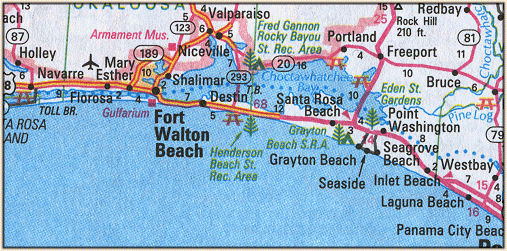
About a 45-minute drive to the west from Destin lies Santa Rosa Sound and
the Gulf Island National Seashore area, my favorite place to fly-fish.
The sound side is a great place for the wading fly-fisher; it has miles of
grass flats, channels, coves and sandbars. Spotted seatrout, redfish, ladyfish
and jack cravelle are readily available in the sound. Across the road, there
are many miles of beaches where ladyfish, pompano, Spanish mackerel and
jack crevalle roam from spring to late fall. Further west is Fort Pickens,
at the junction of Pensacola Bay and Santa Rosa Sound. The West Pass is
larger than its counterpart at Destin. Fort Pickens has miles of beaches
for fishing, but also sand dunes to explore, museums, civil war forts,
bicycle paths, picnic facilities, camping areas, etc.
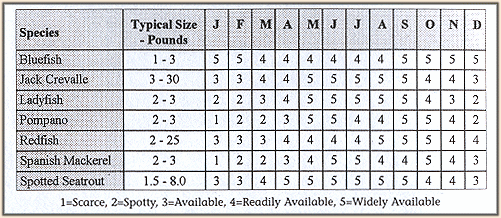
Fishing in the Santa Rosa Sound area is quite seasonal, with the best
fishing times between March and late November. A 9-foot, 8-weight fly
rod is ideal for the back bays, together with a matched weight-forward
floating line and a nine-foot leader. I prefer a 12-pound tippet for
seatrout. Nine- and 10-weight outfits will often we need on the beach
to permit casting into the wind, and a weight-forward intermediate-density
line is preferred to get below the wave action. Shorter leaders are
practical on the beach, but at least a foot of 25- to 30-pound shock
tippet is required bacause of the abrasive mouths of many of our gamefish.
A good saltwater fly reel with a capacity for about 200 yards of 30-pound
backing is appropriate for most of our fame fish off the beach or in
the backbay.
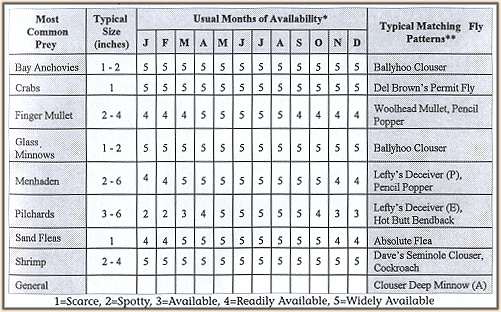
There are many different species of prey in this region, with finger mullet,
pinfish, menhaden, pilchards, shrimp, crabs and sandlfeas being the most
important. The two flies that I use most often are the Seminole Clouser
fish along the shorelines. These two "showy" forms of behavior are most
and the Ballyhoo Clouser. The Seminole Clouser most productive for the back
bay; the spotted seatrout and redfish can't seem to get enough of the gold
flash. The Ballyhoo Clouser is great off the beach for ladyfish, bluefish,
Spanish mackerel, bonito and small jack crevalle. Both Clousers are
usually tied on a size 2 long shank hook. Larger jack crevalle like a
mouthful; thus, Deceivers 4-6 inches long on 1/0 and 2/0 hooks and large
poppers and divers are needed for these formidable game fish. These same
flies will often work very well during our spring cobia run. In late
spring, the pompano run is in full swing and these schooling fish can
usually be found in the breaking waves off the beach. Any small
bonefish pattern, on a size 4 to 6 hook, should work well. The Absolute
Flea pattern is a good choice for pompano. ~ Dave Settoon
Publishers Note: One of the recommended guides in the book for
this region is a FAOL regular, Captain Paul Darby in Shalimar, FL. You can
reach him at: (850)-651-2991 or by email at:
fishnlady1@aolcom.
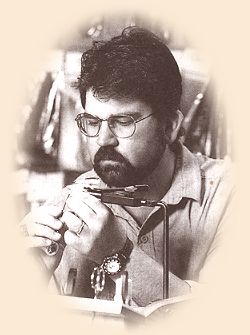
About Dave
Dave Settoon has been living and fishing in northwest Florida for
19 years. Dave has been a fly-fishing guide specializing in wade
fishing and teaching fly-fishing for three years. He is a founding
member of the Panhandle Fly Fishing Club and provides a weekly
fishing report to the Northwest Florida Daily News.
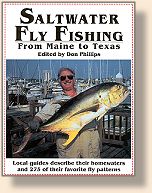
Credits:
This article is an excerpt from Saltwater Fly Fishing, From Maine to
Texas, Edited by Don Phillips and published by
Frank Amato Publications. Check out the Review section for
a complete review.
|





